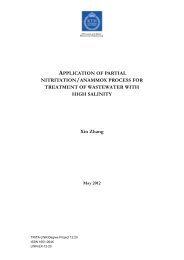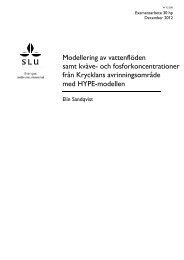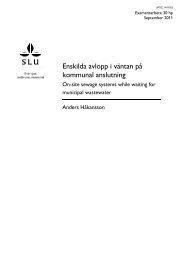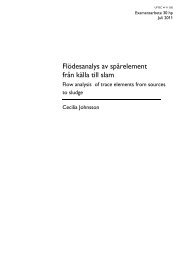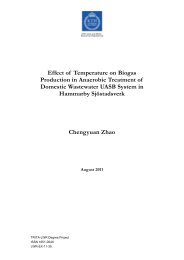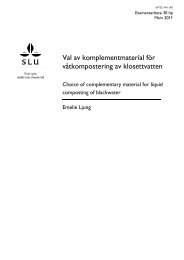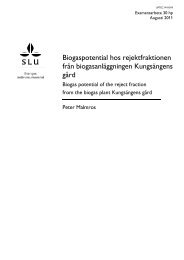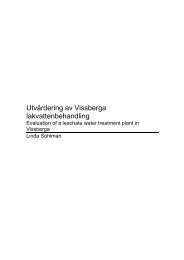Exergy saving and exergy production in municipal wastewater ...
Exergy saving and exergy production in municipal wastewater ...
Exergy saving and exergy production in municipal wastewater ...
Create successful ePaper yourself
Turn your PDF publications into a flip-book with our unique Google optimized e-Paper software.
<strong>Exergy</strong> <strong>sav<strong>in</strong>g</strong> <strong>and</strong> <strong>exergy</strong> <strong>production</strong> <strong>in</strong> <strong>municipal</strong> <strong>wastewater</strong> treatment<br />
human or the system will disappear. This heat dra<strong>in</strong> has been called as<br />
the energy tax which if it gets elim<strong>in</strong>ated the system will collapse<br />
(Bendoricchio, 1997).<br />
The system tends to <strong>in</strong>crease the negative entropy or negentropy<br />
(produce more ordered or higher quality material) <strong>in</strong>side itself <strong>in</strong> order to<br />
survive. This k<strong>in</strong>d of system is called dissipative system as Prigog<strong>in</strong>e<br />
def<strong>in</strong>es <strong>and</strong> it dissipates energy <strong>and</strong> entropy. The methods that are used<br />
<strong>in</strong> the food science for analyz<strong>in</strong>g the calorie-contents can also be used<br />
for the <strong>wastewater</strong> treatment plant <strong>in</strong> order to evaluate the processes,<br />
flows <strong>and</strong> storages (Bendoricchio, 1997). The rate of flow of useful<br />
energy is power <strong>and</strong> <strong>in</strong> SI system it can be measured by joules per unit of<br />
time or watt<br />
1.6. Thermodynamic view of the treatment plant<br />
In biological treatment units <strong>in</strong> a treatment plant, the bacteria digest the<br />
biodegradable material flow<strong>in</strong>g <strong>in</strong> the treatment plant <strong>and</strong> use them to<br />
run the catabolic <strong>and</strong> anabolic reactions of their cells.<br />
If the microorganism is imag<strong>in</strong>ed as a human body its metabolism can be<br />
described with the above described view us<strong>in</strong>g classical thermodynamic<br />
concepts like entropy, Gibb’s free energy <strong>and</strong> enthalpy. This way<br />
thermodynamic science can tell if a specific biological reaction is possible<br />
to happen (Von Stockar et al, 2006). The biological life <strong>in</strong> the treatment<br />
plant can also be a basis for description of treatment plant as a human<br />
body which metabolizes <strong>wastewater</strong>.<br />
Another view to the treatment plant can be achieved from the<br />
description of the ecosystem by Odum where <strong>in</strong> his book he says “an<br />
entity can be considered an ecosystem as long as the major components<br />
are present <strong>and</strong> operate together to achieve some sort of functional<br />
stability, even if for only a short period of time.” He mentions that the<br />
ma<strong>in</strong> feature of all the ecosystems is that <strong>in</strong> all of the ecosystems<br />
autotrophic <strong>and</strong> heterotrophic components have <strong>in</strong>teraction with each<br />
other (Odum et al, 2004). This is similar to what is happen<strong>in</strong>g <strong>in</strong> the<br />
treatment plant. The pollution enter<strong>in</strong>g the treatment plant <strong>in</strong>troduces<br />
entropy <strong>in</strong>to the facility which turns <strong>in</strong>to <strong>in</strong>formation <strong>and</strong> ATP (<strong>exergy</strong>)<br />
<strong>in</strong> the microorganisms through their respiration process.<br />
The Second law of thermodynamic which describes the entropy change<br />
of an open system is as follows:<br />
d S(t) = d e S(t) + d i S(t) (2)<br />
d e S(t) = Entropy provided by the surround<strong>in</strong>g to the system (Entropy<br />
flow) associated with the flow of energy <strong>and</strong> matter<br />
d i S(t) = The entropy produced <strong>in</strong>side the system by<br />
irreversible processes<br />
d i S(t) = dQ(t)/T(t) (3)<br />
dQ (t)= heat <strong>production</strong> caused by irreversible processes <strong>in</strong>side<br />
the system<br />
T (t) = current temperature (◦K) at a given po<strong>in</strong>t <strong>in</strong> the system<br />
Β = dS/dt = (d e S)/dt+ (d i S)/dt (4)<br />
β = rate of entropy <strong>production</strong> or energy dissipation<br />
(dissipative function)<br />
This law says d iS must be zero for reversible transformations <strong>and</strong> should<br />
be positive for irreversible transformation of the system. However,<br />
can be zero, positive or negative for an open system. For adiabatic<br />
7




